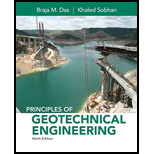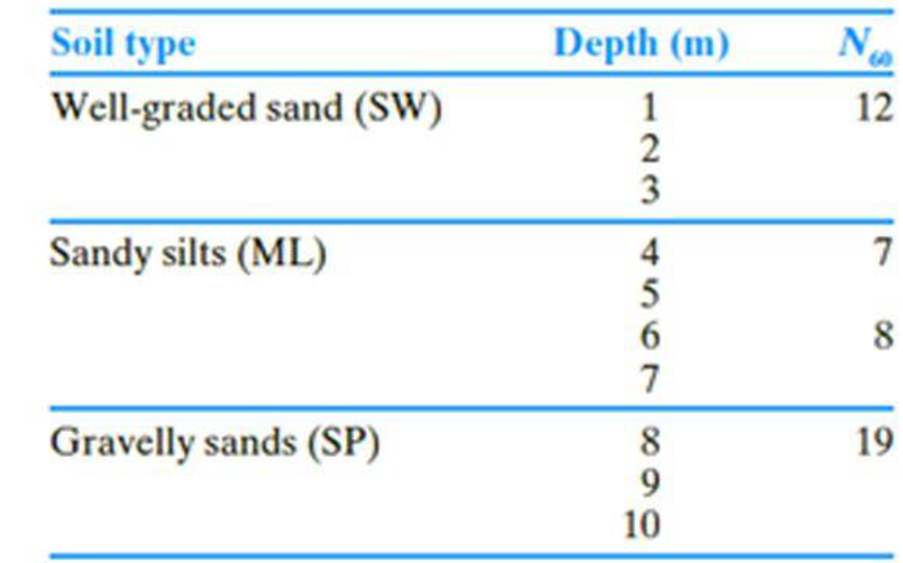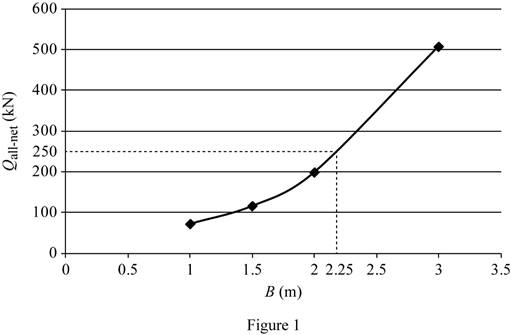
Concept explainers
The following table shows the boring log at a site where a multi-story shopping center would be constructed. Soil classification and the standard penetration number, N60, are provided in the boring log. All columns of the building are supported by square footings which must be placed at a depth of 1.5 m. Additionally, the settlement (elastic) of each footing must be restricted to 20 mm. Since the column loads at different location can vary, a design chart is helpful for quick estimation of footing size required to support a given load.
- a. Prepare a chart by plotting the variation of maximum allowable column loads with footing sizes, B = 1 m, 1.5 m, 2 m, and 3 m. Use a factor of safety of 3.
- b. If the gross column load from the structure is 250 kN, how would you use this chart to select a footing size?
- c. What would be the design footing size for the column in Part (b) if you use Terzaghi’s bearing capacity equation? For the well graded sand, assume that ϕ′ = 33°. Use Fs = 3.
- d. Compare and discuss the differences in footing sizes obtained in Parts b and c.

(a)
Plot the variation of maximum allowable column loads with size of footings to prepare a chart.
Explanation of Solution
Given information:
The location of depth of footing
The given size of the footing B is 1 m, 1.5 m, 2 m, and 3 m.
The settlement of each footing
The given factor of safety
Calculation:
For B value is 1 m:
Determine the depth factor using the relation.
Substitute 1.5 m for
The
The field standard penetration number
Determine the depth of foundation for the field standard penetration number gets averaged.
Substitute 1.5 m for
Determine the averaged
Here,
Substitute 12 for
Determine the net allowable bearing capacity of the soil
Substitute 10 for
Determine the maximum allowable column load
Substitute
For B value is 1.5 m:
Determine the depth factor using the relation.
Substitute 1.5 m for
The field standard penetration number
Determine the depth of foundation for the field standard penetration number gets averaged.
Substitute 1.5 m for
Determine the averaged
Here,
Substitute 7 for
Determine the net allowable bearing capacity of the soil
Substitute 8 for
Determine the maximum allowable column load
Substitute
For B value is 2 m:
Determine the depth factor using the relation.
Substitute 1.5 m for
The field standard penetration number
Determine the depth of foundation for the field standard penetration number gets averaged.
Substitute 1.5 m for
Determine the averaged
Substitute 12 for
Determine the net allowable bearing capacity of the soil
Substitute 9 for
Determine the maximum allowable column load
Substitute
For B value is 3 m:
Determine the depth factor using the relation.
Substitute 1.5 m for
The field standard penetration number
Determine the depth of foundation for the field standard penetration number gets averaged.
Substitute 1.5 m for
Determine the averaged
Here,
Substitute 12 for
Determine the net allowable bearing capacity of the soil
Substitute 12 for
Determine the maximum allowable column load
Substitute
Summarize the calculated values as in Table (1).
| Width B (m) | Column load (kN) |
| 1 | 71 |
| 1.5 | 115 |
| 2 | 198 |
| 3 | 507.5 |
Plot the graph between the size of the footing and the column load as in Figure (1).

(b)
Find the footing size for the given gross column load of 250 kN.
Answer to Problem 16.1CTP
The footing size for the given gross column load of 250 kN is
Explanation of Solution
Given information:
The location of depth of footing
The given size of the footing B is 1 m, 1.5 m, 2 m, and 3 m.
The settlement of each footing
The given factor of safety
Calculation:
Refer Figure (1).
The size of the footing is 2.25 m for the gross column load of 250 kN.
Therefore, the footing size for the given gross column load of 250 kN is
(c)
Find the design column load for the footing size of 2.25 m using the Terzaghi’s bearing capacity equation.
Answer to Problem 16.1CTP
The design column load for the footing size of 2.25 m using the Terzaghi’s bearing capacity equation is
Explanation of Solution
Given information:
The value of cohesion
The soil friction angle
The location of depth of footing base
The width of the footing B is 2.25 m.
The given factor of safety
Calculation:
Determine the net ultimate bearing capacity of the soil
Here,
Take the unit weight of the soil
Refer Table 16.1, “Terzaghi’s bearing-capacity factors–
Take the
Substitute
Determine the net allowable bearing capacity
Substitute
Therefore, the design column load for the footing size of 2.25 m using the Terzaghi’s bearing capacity equation is
(d)
Compare and discuss the differences in footing sizes obtained in parts (b) and (c).
Explanation of Solution
Given information:
The soil friction angle
The location of depth of footing base
The width of the footing B is 2.25 m.
The given factor of safety
Calculation:
The net allowable column load obtained by using Terzaghi’s bearing capacity equation (2,173 kN) is significantly higher than the method based on the
Want to see more full solutions like this?
Chapter 16 Solutions
Principles of Geotechnical Engineering (MindTap Course List)
- Refer to the rectangular combined footing in Figure 10.1, with Q1 = 100 kip and Q2 = 150 kip. The distance between the two column loads L3 = 13.5 ft. The proximity of the property line at the left edge requires that L2 = 3.0 ft. The net allowable soil pressure is 2500 lb/ft2. Determine the breadth and length of a rectangular combined footing.arrow_forwardA shallow square foundation for a column is to be constructed. It must carry a net vertical load of 1000 kN. The soil supporting the foundation is sand. The standard penetration numbers (N60) obtained from field exploration are as follows: FIG. 17.15 The groundwater table is located at a depth of 12 m. The unit weight of soil above the water table is 15.7 kN/m3, and the saturated unit weight of soil below the water table is 18.8 kN/m3. Assume that the depth of the foundation will be 1.5 m and the tolerable settlement is 25 mm. Determine the size of the foundation.arrow_forwardQ#2: Compute the allowable load using the General (Meyerhof) Bearing Capacity equation for the rectangular footing and soil parameters shown in Figure # 2. Use a safety factor of 3 and assume dimension of footing B = 1m, and L = 2m. Subject: Geotechnical Designarrow_forward
- In the excavation of a certain foundation pit, draining water causes upward seepage. The water head difference is 60cm, the length of water flow through the soil is 50cm, the saturated unit weight y=20.5 kN/m². Determine whether the heaving sand happens or not. Give the reason if happens or notarrow_forwardThe site for a commercial building project has the surface elevation lowered by 1.17 m to improve area grading for the building access, parking and drainage. The unit weight of the soil removed was 19 kN/m3. Foundations for the building will be constructed at the level of the new ground surface elevation. Each foundation is 1.5 m by 1.5 m square and imposes a bearing pressure of 275 kPa. Using the 2:1 approximation method determine the net increase in stress (kPa) at a depth of 1.3 m below the footing. Provide your answer to 2 decimal places. Do not include units in your answer.arrow_forwardA strip footing shown is resting on loose sand has the following data (refer to figure h = 0.95 m Df = 1.9 m B = 1.8 m Unit weight of soil above GWT = 1750 kg/m3 Saturated Unit weight of soil = 1950 kg/m3 c = 12 kPa Angle of internal friction = 30 degrees Calculate the following: Net Allowable Bearing Capacity of the footing using Terzaghi’s assumption, kPa. Use FS = 2.5arrow_forward
- Q.3. Three parallel strip footings 3 m wide each and 5 m apart center to center transmit contact pressures of 300, 450 and 150 kN/m2 respectively. Calculate the vertical stress due to the combined loads beneath the centers of each footing at a depth of 4 m below the base. Assume the footings are placed at a depth of 2 m below the ground surface. Use Boussinesq's method for line loadsarrow_forwardA long footing is shown in the figure. N꜀ = 17.69; Nq = 7.44; Nγ = 3.64. Which of the following most nearly gives the ultimate bearing capacity of the soil in kPa?arrow_forwardThree parallel strip footings 3 m wide each and 5 m apart center to center transmit contact pressures of 200, 150 and 100 kN/m2 respectively. Calculate the vertical stress due to the combined loads beneath the centers of each footing at a depth of 3 m below the base. Assume the footings are placedat a depth of 2 m below the ground surface. Use Boussinesq's method for line loads.arrow_forward
- Determine the ultimate bearing capacity of a 1.3 m wide strip footing foundedat a depth of 1m below the ground surface. Soil parameters are φ′ = 36° c′ =10 kPa, and γ = 18 kN/m 3.arrow_forwardthe amount of support needed in an excavation depend on Select one: a. The strength of footing b. The strength of the soil c. The type of foundation d. all the abovearrow_forwardA long strip footing 3.5 ft wide is to be used to support a masonry bearing wall for a building. The subsurface investigation indicates that the soil at the site is a clay with a unit weight of 110 pcf and a cohesion, c, of 1,200 psf. The angle of internal friction is zero. The clay has a rigidity index of 10. The foundation is constructed 3 ft below the ground surface, and the soil backfill is well compacted. Using a factor of safety of 3, what maximum load should the foundation be designed to support per foot of wall length?arrow_forward
 Principles of Geotechnical Engineering (MindTap C...Civil EngineeringISBN:9781305970939Author:Braja M. Das, Khaled SobhanPublisher:Cengage Learning
Principles of Geotechnical Engineering (MindTap C...Civil EngineeringISBN:9781305970939Author:Braja M. Das, Khaled SobhanPublisher:Cengage Learning Fundamentals of Geotechnical Engineering (MindTap...Civil EngineeringISBN:9781305635180Author:Braja M. Das, Nagaratnam SivakuganPublisher:Cengage Learning
Fundamentals of Geotechnical Engineering (MindTap...Civil EngineeringISBN:9781305635180Author:Braja M. Das, Nagaratnam SivakuganPublisher:Cengage Learning Principles of Foundation Engineering (MindTap Cou...Civil EngineeringISBN:9781337705028Author:Braja M. Das, Nagaratnam SivakuganPublisher:Cengage Learning
Principles of Foundation Engineering (MindTap Cou...Civil EngineeringISBN:9781337705028Author:Braja M. Das, Nagaratnam SivakuganPublisher:Cengage Learning


